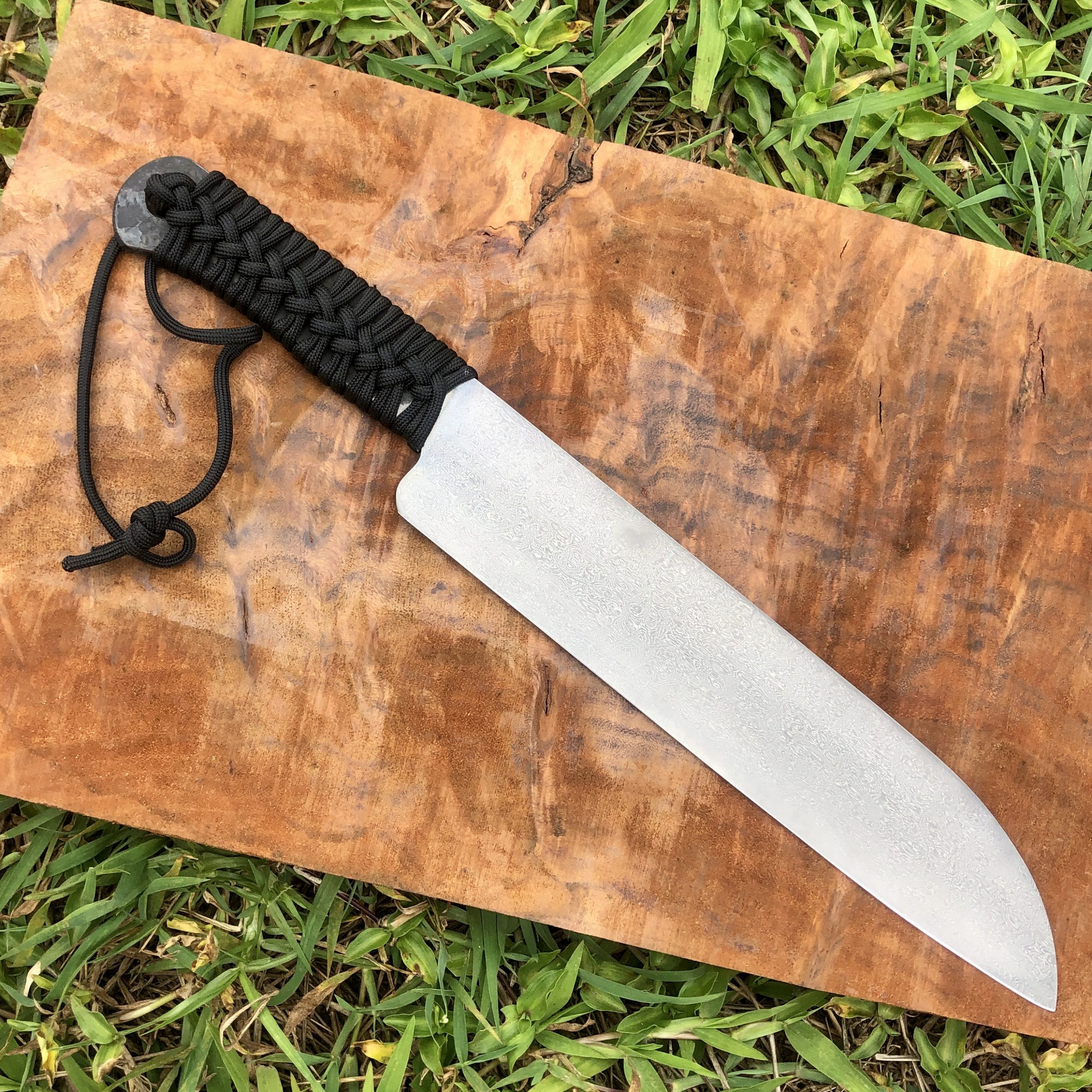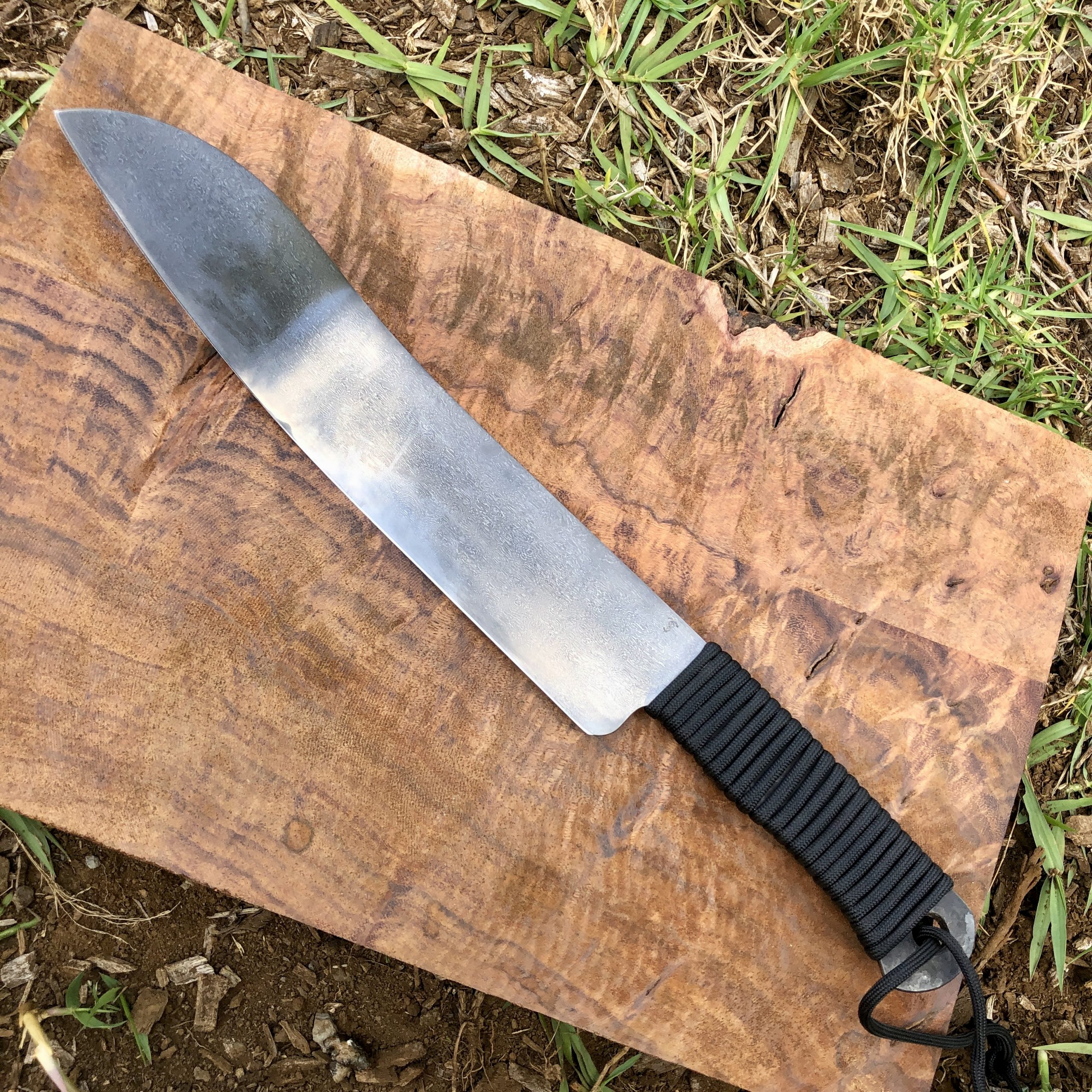Why do we test blades and certify bladesmiths?
Wootz, or Crucible Damascus, is a broad group of materials that are incredibly variable. These variations are the result of initial chemistry, method of melting, cooling/solidification rate, ingot shape, roasting temperature and duration, as well as forging temperatures and methods all the way from the initial state to the finished blade. As with all steels, the heat treating of the blade is also incredibly important, and the results of heat treating depend heavily on all the variables stated above.
What this means currently is that there is no standard expectation when a bladesmith produces a wootz knife. Through testing of blades and certification of bladesmiths we at the International Wootz Society are aiming to establish that standard. The purpose is to reassure the buying public that the smiths they are purchasing from can meet a certain standard, but our goal is not to stifle individual experimentation or to “lock down” a specific formulation or methodology. Testing is instead aimed at certifying the skills and knowledge of the individual bladesmith through testing of one or more submitted blades.
What are the different stages of testing/certification?
Initially, there will be only one level of certification, which will be the Journeyman Wootzsmith. As more smiths are certified as Journeymen, the criteria for the Master Wootzsmith rating will be clarified. The Journeyman certification will require the successful testing of three blades, along with the presentation of sufficient evidence showing an existing body of work. This demonstrates that the smith has been working in wootz for some time and has perfected their own version of a wootz process. The Master Wootzsmith rating will be similar, but will require that the test blades meet certain chemistry and pattern requirements, thus demonstrating that the smith has the knowledge and skill to work outside their normal methodology. The Master rating will also require additional knowledge and skills tests.
Journeyman Wootzsmith Certification.
To apply for certification, the smith must first provide sufficient proof of prior experience in making wootz and forging blades from it. This can be in the form of pictures, websites, social media, etc. showing images and/or videos of ingots being made and of knives that are clearly wootz and clearly show the Smith’s maker’s mark. The Certification Officer will determine whether the applicant has provided sufficient evidence to qualify for testing. If the applicant is deemed to have a sufficient body of work, then they can proceed to testing. Applicants without a sufficient body of work will be asked to compile additional evidence prior to applying again.
If the applicant is deemed to have provided sufficient evidence, then they can proceed to testing. All testing will be carried out by the Certification Officer or a proxy appointed by the Officer. By putting the testing in the hands of the Officer we are better able to control the variables of testing the blade; this is a test of the smith’s ability to make a functional wootz knife, not their skill in using that knife. Applicants must submit 3 knives for testing, and all of the knives sent will be performance tested, and all testing will be videoed. Video will be shared on the IWS YouTube channel, and if permission is granted, on the IWS social media.
Why test more than one knife?
We at the IWS recognize that wootz can be somewhat fickle and can have microscopic flaws that might only become obvious during the rigors of testing. Such flaws could result in small chips or roughness at the edge that would affect cutting ability. All of the knives that are sent will be put through all of the performance tests (if possible), though, and catastrophic failure of any of the knives will result in failure of the applicant. Barring any catastrophic failures, at least two of the knives must pass all of the performance tests. Testing of three knives better establishes that the smith has control of their process and can consistently produce a high-performance blade.
The Test Blades.
The three knives that are submitted must meet the following criteria. You can see pictures of the example blade here.
1) Be appropriately polished and etched to reveal the wootz patterning on the entire blade surface. If the blade has been differentially hardened it is allowable for the pattern to be less visible in either the hardened or unhardened section. Blades can show any type of wootz pattern, but blades that are suspected of being made from modern production steel may be further tested to establish their pedigree. Blades found to be modern steel rather than wootz will be summarily failed and the applicant may face expulsion from the IWS.
2) Have a blade not more than 10″ long and not more than 2″ wide, and a total length of no more than 15″. Thickness at the spine must be 3/16″ or less, but otherwise the design and geometry are in the hands of the applicant. The handle design must follow the approved pattern and construction; this is to maintain testing consistency and for the safety of the Certification Officer.
3) All blades must be made by the applicant, starting from raw materials and carrying all the way through to the finished knife. Applicants found to be using another smith’s steel, or whose steel has been finished into a knife by another smith, will be summarily failed.
4) All test knives should be in a cleanly finished state, meaning that the blade is well polished and etched, there are no burrs or sharp edges on the handle, and the handle wrap is tight and securely attached.
The Performance Tests.
All three knives will be subjected to all tests unless there is catastrophic failure in one of the tests. The Certification Officer will endeavor to test all blades in a consistent manner, thus providing the most accurate comparison from blade to blade and applicant to applicant. The tests will be as follows:
1) Inspection. The Officer will begin by inspecting all three test blades to ascertain whether they meet the testing criteria, and all comments will be recorded in the video and later converted to written notes. If there appears to be any shipping damage to the blades that would affect cutting performance, the Officer will dress the edge as needed prior to moving to the second test.
2) Paper Slice. A piece of standard office paper will be rolled to a 1″ x 11″ cylinder and the ends taped. The test knife will be used to make several, low-angle, slicing cuts into or through the cylinder. This tests the sharpness and texture of the edge and will help illustrate if there are any small chips or other areas of roughness. This also helps reveal the sharpening angle; blades with an overly steep sharpening angle will perform poorly in this test. If the first slice goes poorly the Certification Officer will lightly hone the blade and continue with the test; the Officer will not reset the edge angle, but merely hone the edge to remove any possible burr that might exist. If the blade continues to perform poorly this will be considered a failure.
3) Lumber Chop. Each test knife will be used to chop two times through a standard 2×4 piece of framing lumber. The board will be of moderate density, untreated, and free from visible knots. The board will be dry but not aged. The board will be supported on a wooden platform that is free from dirt and debris that might affect the performance of the test knife. The Certification Officer will chop through 1/2 way from one side, then rotate the board and complete the cut from the opposing side; this further minimizes contact between the test knife and the supporting surface. The knife will be used to cut through the 2×4 twice in this manner. If the edge visibly chips or deforms then this will be considered a failure. If the blade breaks or loses a large chip then this will be considered a catastrophic failure.
4) Paper Slice. Test #2 is repeated as a way to detect any damage to the edge that was not revealed by the visual inspection. The test knife should still cut the paper cylinder cleanly, and any substantial tearing of the paper will be considered a failure.
5) The Flex. The test blade will be clamped tightly in a leather-padded vise at roughly 1/3 of the blade length back from the tip. An appropriate lever will be tightly clamped to the handle, and the blade slowly flexed until the base of the blade is at 90 degrees to the tip. It is allowable for blades to either remain fully bent or to spring back once the pressure is removed. Minimal cracking at the edge is allowable, but any cracking in the spine half of the blade represents failure in this test. If the blade snaps completely then this will be deemed a catastrophic failure.
This series of tests will be carried out on all three of the applicant’s blades unless the Certification Officer deems it to be unsafe to continue. An example would be excessive chipping in the Lumber Chop test, which would indicate a brittle blade that is likely to fail catastrophically in The Flex. The other blades will still be tested as thoroughly as possible, however; by completing as many of the tests as possible on each blade, even a failed Journeyman Performance Test can still provide the applicant with useful information for future attempts.
In order to pass the Performance Test and become a Certified Journeyman Wootzsmith, two out of the three test blades must succeed in all five of the tests. It is allowable for one of the knives to fail in one or more test, meaning that it cuts poorly, chips slightly, or has some minor cracking in the flex test. If any of the three blades fail catastrophically or are deemed unsafe to test, then this will be considered an overall failure on the Performance Test.
Cost of Testing.
There will be a charge for these tests in order to cover materials costs, analysis if required and the time of the person performing the test. If you would like further details or to begin the certification process, please contact the Certification Officer through our contact form.
What does testing look like?
Peter Burt tested several of his blades to demonstrate the testing process and to show that the testing regime is reasonable. If you would like to watch a video of the testing it can be found here. Peter has also submitted pictures of his blade post-testing to illustrate the wootz pattern as well as that there are no cracks that might not be visible in the video, and those pictures are available here. Smiths who are interested in testing for the Journeyman Wootzsmith certification are encouraged to carry out their own testing on several blades before submitting blades to the Certification Officer.

